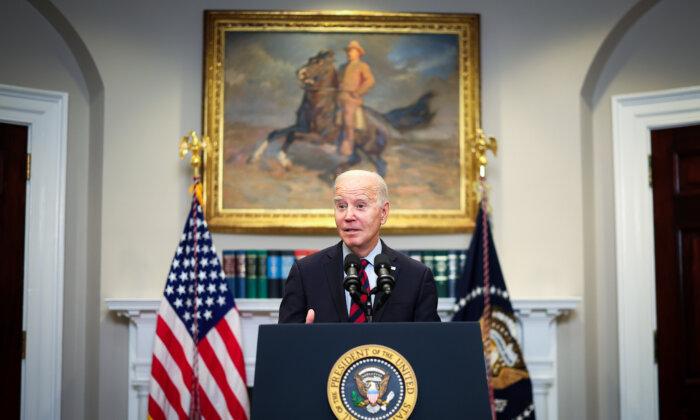President Joe Biden defended his administration’s decision to waive federal statutes in South Texas to allow for the construction of 20 miles of U.S.-Mexico border wall, stating on Oct. 5 he had no choice but to use previously approved federal funds for the project.
President Biden said that he had tried to “redirect” the money from the border wall project—allocation under the Trump administration.
“The money was appropriated for the border wall. I tried to get them to reappropriate, to redirect that money,” President Biden said in his address. “They didn’t. They wouldn’t. In the meantime, there’s nothing under the law other than they have to use the money for what it was appropriated for. I can’t stop that,” he said.
When the president was asked a follow-up question about whether he thought the border wall was effective, he replied with a firm “no.”
“We asked Congress to reappropriate the fund, but they refused to do it. We need better technology, not a wall.”
When asked repeatedly about the issue, the press secretary seemed frustrated, insisting that the president has been consistent in his approach to border security.
“He called on Congress to reappropriate the funds for smarter, more effective enforcement uses. Congress failed to do so,” LeBolt added.
Announced Changes
The Biden administration announced on Oct. 5 that 26 federal laws were waved in South Texas to allow border wall construction, signaling the administration’s first use of broad executive power to pave the way for building more border barriers.The Department of Homeland Security (DHS) posted the announcement on the U.S. Federal Registry with few specifics regarding the construction in Starr County, Texas, which is part of a Border Patrol sector with “high illegal entry.”
DHS has waived a number of federal rules—including the Clean Air Act, the Safe Drinking Water Act, and the Endangered Species Act—in order to begin construction using 2019 appropriations from Congress to build a wall along the southern border.
Environmental law violations that could otherwise be reviewed and possibly litigated are waived.
The announcement did not include any maps, but one that was made public during the comment period showed that the construction might extend the current border barrier system by as much as 20 miles.
About 450 miles of barriers were constructed along the southwest border between 2017 and January 2021, all under the Trump administration.
After the Biden administration temporarily halted them at the beginning of his presidency, Texas Gov. Greg Abbott revived them as part of his immigration crackdown at the state level.
Border Insecurity
A recent report by El Paso’s Mayor Oscar Leeser indicates that the border city is “at a breaking point” amid a massive increase in illegal immigration.The influx of primarily Venezuelan asylum seekers is part of a larger influx of illegal immigrants who traveled perilous bus and freight railroad routes to Mexican border towns near San Diego, California, and the Texas cities of El Paso and Eagle Pass.
Mr. Lesser stated that El Paso intends to open a new shelter and chartered five buses on Oct. 7 to transport illegal immigrants to New York, Chicago, and Denver.
“We deployed the Texas National Guard, DPS, and local law enforcement. We are building a border wall, razor wire, and marine barriers. We are also repelling migrants.”
The governor’s office has also deployed more buses to ship illegal migrants to sanctuary cities, such as New York and Chicago, saying the state is “at capacity.”







